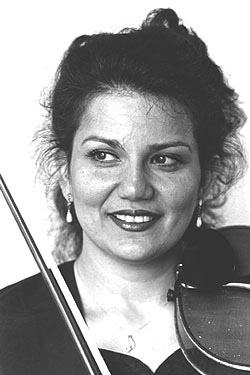| Music | Germany | ||||||||||||||||||||||||||||||||||||||||||||||
BAFA © 2010. All material here is copyrighted. See conditions above. |
Parisa Badiyi violinist and educator, living in Germany |

Parisa Badiyi. |
Parisa was born in Tehran. As the daughter of well-known violinist, Rahmatollah Badiyi, she was exposed to different music styles from her early childhood.
|
About Persian music The classical music of Iran is based on the radif, which is a collection of some 228 goushehs or old melodies. These have been handed down by the masters to the students through the generations. Over time, each master's own interpretation has shaped and added new melodies to this collection, which may bear the master's name. Most well-known musicians agree that the best and most famous radifs, for performing as well as teaching, were written by three of the masters. One was Mirzá Abdu'lláh, the first Bahá'í musician.The preservation of these melodies greatly depended on memory and mastery, because the interpretive origin of this music was handed down only through oral tradition. The radif contains several maqams, which is a specific sonic space (modi). The maqams are distinguished from each other by their note intervals and the form of the movement of the melodies within them. A dastgah may contain about 10 to 30 goushehs. The principal goushehs of the dastgah specify the different maqams within that dastgah. The instrumental radif and the vocal radif are different rhythmically, but their melodic structures are the same. Persian music differs from western music in the following ways: ˇ It uses quart-tones(1/4). A scale in western music consists of 12 chromatic and dyatonic tones whereas a scale in Persian music has 24 quart-tones. ˇ It has no Polyphonic sound. ˇ Rhythm in the melodies takes three different forms: symmetric, asymmetric, and free form. ˇ The rhythm is greatly influenced by the rhythm and meter of the Persian poetry. ˇ In Persian singing, there is a special trill for the voice, which gives beauty and elegance to the song. Arts Dialogue, November 2002, page 4. |
|
Arts Dialogue, Dintel 20, NL 7333 MC, Apeldoorn, The Netherlands email: bafa@bahai-library.com |